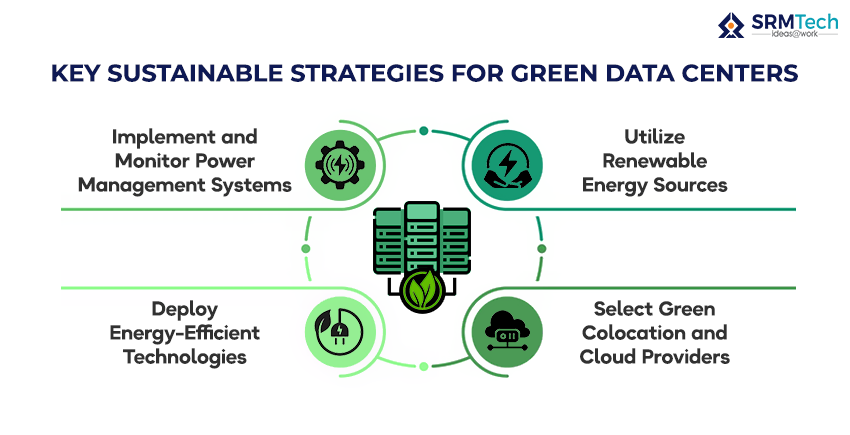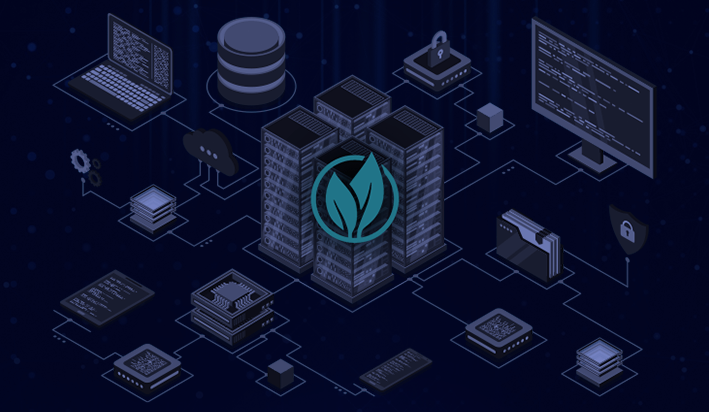In the fast-evolving world of technology, the imperative for businesses to modernize their IT infrastructure is undeniable. Data centers and supercomputers, the cornerstones of our digital age’s IT infrastructure, play a pivotal role in processing, storing, and networking vast amounts of data to power the services like video streaming, gaming, and AI (Artificial Intelligence) we rely on daily. However, the staggering surge in global data demands comes at a considerable environmental cost, with data centers now sharing a carbon footprint akin to the aviation industry by constituting 3% of the global electricity supply and 2% of greenhouse gas emissions. This calls for a transformative solution, prompting the exploration of green data centers as a ray of hope. But what additional advantages do they provide, and how are these eco-friendly data centers implemented and managed? Read on to find out more.
What is a Green Data Center?
A green data center is a type of data center that is designed to minimize its environmental impact by employing energy-efficient technologies and sustainable practices. It aims to reduce energy consumption, carbon emissions, and overall environmental footprint. Green data centers often incorporate renewable energy sources, advanced cooling systems, and innovative infrastructure designs to optimize energy efficiency.
As global data volumes are poised to hit approximately 175 zettabytes by 2025, the surging demand for data-based services has increased energy consumption within data centers. In response, a beacon of sustainable innovation emerges – the green data center.
Green Data Center Market Trends
According to market research, the global green data center market size was valued at $49.2 billion in 2020 and is projected to reach $140.3 billion by 2026, exhibiting a CAGR of 19.1% from 2020 to 2026.
These stats clearly show that the green data center market is gaining traction globally, and businesses are also increasingly adopting green data center solutions to reduce the environmental impact of their IT operations.
With governments worldwide implementing policies and regulations to promote energy-efficient and sustainable IT practices, the green data center market is projected to grow steadily, driven by the increasing need for energy efficiency, environmental responsibility, and cost reduction in IT operations.
Benefits of Green Data Centers
If your company hasn’t adopted a green data center yet, the moment to do so is here. Here are the significant advantages of adopting a green data center into your IT ecosystem.
-
Cost Savings:
Reduced energy consumption and efficient resource usage lead to lower operational costs.
-
Environmental Sustainability:
Minimized carbon footprint by extensively using eco-friendly energy resources.
-
Corporate Reputation:
Demonstrating commitment to environmental responsibility enhances the company’s image and positions the company as an innovator in the industry.
Key Sustainable Strategies for Green Data Centers
Businesses can follow the systematic approaches mentioned below to implement green data centers successfully.

Implement and Monitor Power Management Systems
Introduce power management systems that automatically shut down or reduce the power usage of idle servers and other IT assets. This proactive measure significantly lowers overall energy consumption, promoting efficiency and sustainability. Also, regularly monitor data center energy usage to pinpoint areas for improvement. This ongoing analysis helps identify opportunities to enhance energy efficiency and reduce the overall carbon footprint.
Deploy Energy-Efficient Technologies
Use energy-efficient servers, storage, and networking devices primarily designed to consume less power while delivering optimal performance. Also, embrace LED lighting, hot aisle/cold aisle containment with variable speed CPU fans, and liquid cooling systems to improve cooling efficiency and reduce power usage. By integrating these technologies, companies can substantially decrease the energy required to support IT operations, fostering a green data center infrastructure.
Utilize Renewable Energy Sources
Implementing renewable energy sources such as solar and wind, alongside Battery Energy Storage Systems (BESS), significantly reduces data center energy usage. BESS stores excess energy during peak renewable production, ensuring a consistent power supply even during low-power generation periods. Integrating this facility with grid connectivity, considerably minimizes reliance on non-renewable sources. Government incentives and industry regulations further drive this shift, promoting sustainable and cost-effective operations for data centers while contributing to global environmental goals.
Select Green Colocation and Cloud Providers
Choosing Green Colocation and Cloud Providers is a strategic move for organizations relying on external data centers or cloud services. Opting for service providers prioritizing renewable energy sources and maintaining environmentally friendly data centers denotes a curious commitment to sustainability. These kinds of engagements not only demonstrate corporate responsibility but also contribute to a broader environmental impact by fostering a collective effort towards an eco-friendly digital landscape.
Employing Innovative Technologies for Sustainability in Data Centers
The goal of establishing green data centers is to promote green businesses and contribute to a better future for everyone. The key to this is minimizing reliance on power, energy, and cooling resources while sustaining the required performance levels. Incorporating innovative technology practices to support operations is crucial in pursuing a more environmentally friendly and sustainable business landscape.
Server and Storage Virtualization
While considered a conventional approach, server and storage virtualization remains integral to green data center initiatives. Operating multiple virtual machines on a single physical server reduces the demand for extra hardware, enhancing existing infrastructure efficiency. Despite its long existence, this technology remains advantageous in minimizing energy consumption. Demonstrating ongoing relevance, this traditional method promotes environmental sustainability and significantly lessens the overall ecological impact of data center operations.
Containerization
Containerization, as a pivotal software deployment method, encapsulates an application’s code along with its essential files and libraries, ensuring its ability to run seamlessly on diverse infrastructures. This innovative technology streamlines application deployment, concurrently minimizing data center space requirements and enhancing operational efficiency. By optimizing processes, containerization contributes to creating a more resource-efficient and streamlined data center environment.
Cloud Computing
Cloud computing, through its on-demand resource access model, propels the green data center agenda by leveraging various technologies playing a pivotal role in fostering environmentally sustainable data center practices. Infrastructure-as-a-Service (IaaS) and Platform-as-a-Service (PaaS) models significantly reduce energy and resource needs by eliminating the ownership and maintenance of physical infrastructure. Additionally, microservices architecture within cloud environments further enhances efficiency. Microservices enable modular, scalable, and independent application components, optimizing resource utilization and reducing the ecological footprint.
Optimizing Green Data Centers with Advanced Technologies
Harnessing intelligent monitoring powered by AI/ML technologies allows green data centers to achieve heightened performance. These technologies provide predictive insights into energy consumption patterns and the status of infrastructure elements, facilitating timely maintenance scheduling for efficient operations and overall sustainability.
In tandem, Edge Computing and the Internet of Things (IoT) drive eco-friendly practices by bringing data processing closer to the resource and minimizing energy consumption by eliminating long-distance transfers. Integrating specialized IoT devices enhances operational efficiency, aligning data management with sustainable and eco-friendly principles in modern data center practices.
How do we measure the sustainability of a green data center?
Assessing the sustainability of a green data center involves vital metrics, where Power Usage Effectiveness (PUE) and Carbon Usage Effectiveness (CUE) play pivotal roles.
PUE (Power Usage Effectiveness)
PUE, devised by the Green Grid Association, gauges data center efficiency by comparing total power usage to the power delivered to IT equipment. An ideal ratio of 1.0 signifies perfect efficiency, with all power reaching IT equipment without losses in cooling or transmission. Targeting a PUE equation below 1.5 is standard, while green data centers can achieve an impressive PUE of less than 1.1.
The formula to calculate PUE – PUE= total facility power/IT equipment energy
Total facility power means the entire power consumed by the facility, encompassing all data center hardware, cooling systems, power distribution components, and lighting installations. On the other hand, IT equipment energy specifically denotes the energy utilized to operate storage and networking equipment, along with control devices like workstations and monitors.
How can you calculate the power usage?
Check how much energy the whole building uses by looking at the utility meter. If the data center is in a place with other offices, only look at the meter that gives power to the data center. If it is not on its own meter, identify how much energy other parts of the building use and take that away (subtract). Or leverage Data Center Infrastructure Management (DCIM) software with sensors that show how much energy is being used in real-time.
CUE (Carbon Usage Effectiveness)
Complementing PUE, CUE measures a data center’s carbon emissions efficiency. It calculates the ratio of total CO2 emissions from energy consumption to the energy consumption of IT equipment.
The formula to calculate CUE – CUE = CO2 Emissions Caused by Total Data Center Energy / IT Equipment Energy
In an ideal scenario, CO2 emissions data would be sourced from real-time CO2 meters, which gather information directly from the local power source—let it be diesel/ natural gas/ fuel/ oil/ turbines /coal /generators/fuel cells, or any other applicable source. However, suppose access to real-time CO2 emission data is unavailable. In that case, the alternative involves performing calculations based on data provided by the generator manufacturers, accounting for both emission rates and fuel sources.
These metrics comprehensively evaluate a green data center’s environmental impact and efficiency. And if it’s high, businesses can look out for assessing and implementing better practices.
IT Giants Implementing Green Data Centers
Hyper scalers like Google, Microsoft, and AWS (Amazon Web Services) dominate the IT market and drive the adoption of energy-efficient green data center solutions, such as power, IT, and cooling. Let us look at how they use renewable resources to implement green data centers.
Google stands out in the tech industry by achieving 100% reliance on renewable energy for its data centers. This robust commitment underscores a proactive approach toward environmental sustainability, setting a high standard for the industry. Google strategically engages in PPAs to secure significant solar power resources. The recent agreement with SB Energy in Texas for 942MW exemplifies their dedication to supporting and expanding renewable energy projects. Google’s embrace of renewable energy powers its operations and sets a benchmark for eco-friendly practices within the technology market.
Amazon (AWS)
AWS, Amazon’s cloud computing arm, fulfills an impressive 85% of its energy needs through renewable sources. This highlights a substantial commitment to integrating green practices into its operations. AWS engages in strategic PPAs, such as the one with AES Corp, for 450MW solar power in California. This demonstrates proactive efforts to secure renewable energy for its data centers. The plan to develop two solar farms in Louisiana, USA, reveals Amazon’s ongoing dedication to expanding and diversifying its renewable energy portfolio.
Microsoft
Microsoft sets a noteworthy goal to power all its facilities entirely with renewable energy by 2025, reflecting a solid commitment to a sustainable energy future. The 110MW PPA with AES in California showcases Microsoft’s tangible steps in securing a renewable energy supply, aligning with its long-term sustainability objectives. Microsoft’s emphasis on transitioning across its operations to renewable energy reflects a holistic commitment to reducing its environmental footprint and fostering sustainability.
In a nutshell, green data centers represent a crucial solution to the environmental impact of traditional data infrastructure. Beyond cost savings and corporate reputation, adopting these eco-friendly alternatives is a moral imperative. Businesses must recognize their role in environmental conservation, promoting sustainability, and ensuring regulatory compliance. A collective commitment to implementing green data centers is a need of the hour for a responsible future digital landscape, aligning technological progress with global environmental responsibility.






